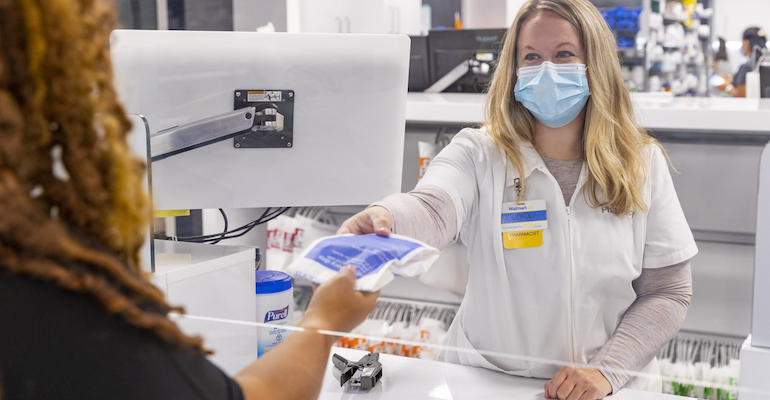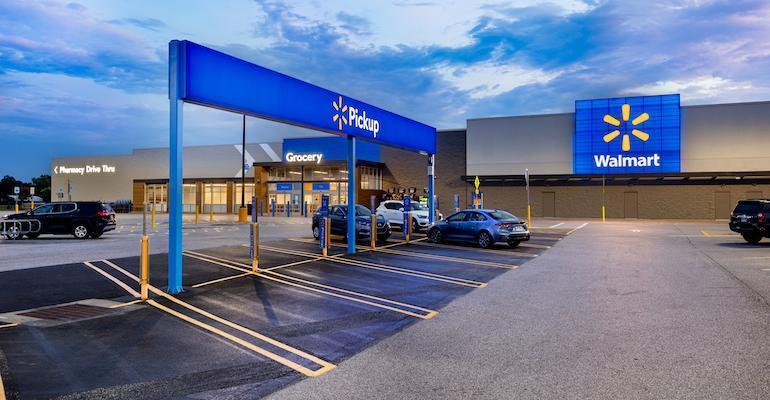Walmart added to strong year-ago growth in its fiscal 2023 third quarter, with net and comparable sales increases exceeding 8% at Walmart U.S. and 12% at Sam’s Club.
Bentonville, Ark.-based Walmart also topped the high end of Wall Street’s forecast for adjusted earnings per share (EPS) by a dime.
For the quarter ended Oct. 31, Walmart totaled revenue of $152.81 billion, up 8.8% from $140.52 billion a year earlier. Excluding the impact of foreign exchange, revenue advanced 9.8% to $154.3 billion, Walmart said Tuesday. The uptick compared with 4.3% revenue growth (3.3% in constant currency) in the fiscal 2022 quarter.
Grocery helps drive U.S. sales growth
At Walmart U.S., third-quarter net sales rose 8.5% to $104.78 billion from $96.61 billion a year ago. Comp sales climbed 8.5% year over year (8.2% excluding fuel), with the average ticket size up 6% and the number of transactions edging up 2.1%. On a two-year stack, comp sales gained 17.4%, a 570-basis-point acceleration from Q2, while transactions grew 7.8%.
Net sales were driven in part by strong grocery share gains, including from high-income households, according to Walmart, as well as robust seasonal sales (led by back-to-school and Halloween). Meanwhile, the retailer said, comp sales showed strength in food categories and private brands and were lifted by higher average ticket and store transactions.
E-commerce sales for Walmart U.S. jumped 16% in Q3 and contributed 80 basis points to overall comp-sales growth, Walmart reported. Including the fiscal 2022 quarter’s 8% gain, online sales were up 24% over two years.

Walmart noted that transaction count was up at both Walmart U.S. and Sam's Club for the quarter.
Walmart noted that U.S. e-commerce in the third quarter reflected 40% growth in advertising plus strength in pickup, delivery, marketplace and fulfillment services.
On the fulfillment side, Walmart U.S. now has about 4,600 pickup sites (+300 from a year ago) and same-day delivery from more than 3,900 stores (+600 from a year ago). More than 235 stores also have undergone remodels, the company said.
Among product categories, grocery posted comp-sales growth in the mid-teens in the third quarter, fueled by mid-teens growth in food and a gain in unit sales, reversing a slight decrease from Q2, Walmart reported. Two-year comp growth for grocery was up 20%. Pet, personal care and beauty sales also were strong, boosted by inflation.
The health and wellness category saw high-single-digits comp-sales growth in the quarter, reflecting brand-name drug inflation and higher immunization volumes, partially offset by fewer COVID-19 vaccinations, Walmart said.
At Sam’s Club, net sales came in at $21.4 billion in the third quarter, up 12.8% from $18.97 billion in the prior-year period, when sales surged 19.7%. Membership income increased 8%, with record total member count.

Walmart closed out Q3 with about 4,600 pickup sites, up 300 from a year earlier.
Comp sales at Sam’s climbed 12.7% overall and were up 10% excluding fuel, compared with growth of 19.8% (13.9% excluding fuel) a year ago. Transactions were up 4.8% and the average basket grew 4.9%. On a two-year stack, the wholesale club chain’s comp sales increased 32.5%, Walmart said. E-commerce sales rose 32% — atop 32% growth a year earlier — and contributed 120 basis points to total comp-sales growth.
Sam’s tallied mid-teens comp-sales increases in grocery/beverage and low double-digit growth for the fresh/freezer/cooler category, with fresh meat and seafood, produce and floral seeing strong results, Walmart said. Consumables and health-and-wellness comps advanced by mid-single digits.
Overall U.S. comparable sales, including Walmart U.S. and Sam’s Club, rose 9.2% in third quarter (8.5% excluding fuel) versus 11.1% (9.9% without fuel) in the fiscal 2022 quarter.
International performance provides lift
Walmart International saw third-quarter net sales rise 7.1% to $25.3 billion from $23.63 billion a year earlier. In constant currency, international net sales climbed 13.3% to $26.77 billion. Walmart Mexico led with double-digit net and comp sales growth, while China and Canada also turned in solid gains.
“We had a good quarter with strong top-line growth globally led by Walmart U.S. and Sam’s Club, along with Flipkart and Walmex. Walmart U.S. continued to gain market share in grocery, helped by unit growth in our food business,” Walmart President and CEO Doug McMillon said in a statement.
“We significantly improved our inventory position in Q3, and we’ll continue to make progress as we end the year,” McMillon explained. “From ‘The Big Billion Days’ in India, through our ‘Deals for Days’ events in the U.S. and a Thanksgiving meal that will cost the same as last year, we’re here to help make this an affordable and special time for families around the world.”
Opioid settlement reached
Also on Tuesday, Walmart announced that it has agreed to a $3.1 billion nationwide opioid settlement framework, which the company noted is “designed to resolve substantially” all opioid lawsuits and potential lawsuits by state, local and tribal governments.
“Walmart believes the settlement framework is in the best interest of all parties and will provide significant aid to communities across the country in the fight against the opioid crisis, with aid reaching state and local governments faster than any other nationwide opioid settlement to date, subject to satisfying all settlement requirements,” the company said in a statement. “Walmart is proud of our pharmacists and our efforts to help fight the opioid crisis. Walmart strongly disputes the allegations in these matters, and this settlement framework does not include any admission of liability. Walmart will continue to vigorously defend the company against any lawsuit not resolved through this settlement framework.”

In the opioid settlement, at issue was a dilemma faced by pharmacists — Deciding whether not filling potentially illicit opioid prescriptions interferes with the medical decisions of doctors licensed the prescribe controlled substances.
In October 2020, Walmart had filed a lawsuit against the U.S. Department of Justice (DOJ) and the Drug Enforcement Administration (DEA) over the responsibility of the company and its pharmacists in flagging suspicious opioid prescriptions. In the suit, Walmart Inc. v. DOJ, filed in the U.S. District Court for the Eastern District of Texas, the retailer asked the court to clarify the roles and responsibilities of pharmacists and pharmacies under the Controlled Substances Act (CSA).
At issue was a dilemma faced by pharmacists when dispensing opioid painkiller medications: Deciding whether not filling potentially illicit opioid prescriptions — i.e. those suspected of drug abuse or diversion by the patient — interferes with the medical decisions of doctors licensed the prescribe controlled substances.
Then in December 2020, the DOJ filed a civil suit alleging that Walmart violated the CSA through its pharmacies nationwide by filling thousands of controlled substance prescriptions that were “not issued for legitimate medical purposes or in the usual course of medical practice” and were dispensed “outside the ordinary course of pharmacy practice.” At the time, Walmart blasted the suit as “misguided and misleading” and noted that it informs patients about the risks of controlled substance medications and has “always empowered” its pharmacists to refuse to fill questionable opioid prescriptions.
Impact to the bottom line
On the earnings front, Walmart reported a fiscal 2023 third-quarter consolidated net loss (attributable to the company) of nearly $1.8 billion, or 66 cents per diluted share, compared with net income of $3.11 billion, or $1.11 per diluted share, a year ago. Excluding a losses from unrealized investment losses ($1.34 per diluted share) and legal costs connected with the opioid settlement ($1.22 per diluted share), adjusted net earnings per share were $1.50, well over the high end of Wall Street’s projection.
Analysts, on average had forecast adjusted EPS of $1.32, with estimates ranging from a low of $1.27 to a high of $1.40, according to Refinitiv.
Walmart cited the strong Q3 performance in raising its full-year guidance for fiscal 2023. The company now expects consolidated net sales growth of about 5.5% (+6.5% excluding divestitures). Walmart U.S. comp-sales growth is projected at 5.5%, excluding fuel. Adjusted EPS is slated to decline an estimated 6% to 7% (5% to 6% excluding divestitures).
Wall Street’s consensus estimate is for fiscal 2023 adjusted EPS of $5.88, with projections running from $5.70 to $6.43, according to Refinitiv. Revenue is pegged at $600.48 billion, running from a low of $594.23 billion to a high of $605.56 billion.
Walmart finished the third quarter with 10,585 stores worldwide, including 4,735 Walmart and 600 Sam’s Club stores in the United States and 5,250 international locations.





